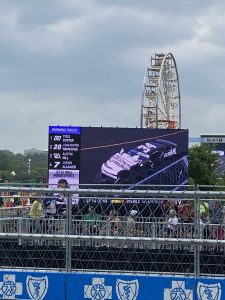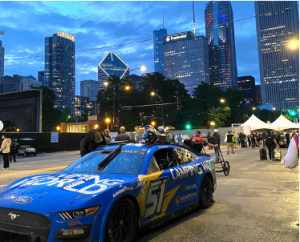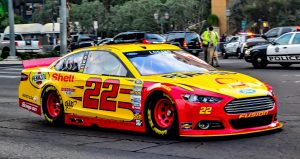Better read fast because as Ricky Bobby once said, ‘If you ain’t first, you’re last.’
If you breathed the same air as me this summer, you probably know I became a huge NASCAR fan. After hearing the first car roar on Michigan Avenue (even before walking into the Chicago Street Race), NASCAR earned my allegiance. So lucky you, you get to read about it too, haha! However, this time, with a recently acquired trademark lens.
How did I learn about trademarks?
This year, my classes have intellectual property all over them. First, I am enrolled in an intellectual property (IP) survey course covering trade secrets, trademarks, copyrights, and patents. Additionally, my appellate legal writing class focuses on IP and discusses patent issues like patent misuse and patent exhaustion. Next semester, I will compete with the trademark and unfair competition moot court team as an oralist in the International Trademark Association competition.
However, the IP highlight of this year thus far is seeing learned concepts in previous unexpected experiences. After learning about trademarks, NASCAR was one of the first things that came to mind.
What is a trademark?
A trademark may be any word, name, symbol, or design that identifies a specific product or service from a particular source and distinguishes it from others. Trademarking is critical to businesses as it helps to build their brand and strengthen customer relationships. Having a trademark gives owner, the right to assign the trademark so that others can use it (licenses or assignments), and the right to exclude others from confusing uses of the mark, i.e. trademark infringement. For example, McDonald’s has the right to use the word “McDonald’s” as its trademark in connection with fast-food restaurants and prevent another from using the same or similar mark for such services. But, McDonald’s would not have the ability to exclude others from using a similar mark on other types of goods like jewelry or computers, where there is no likelihood of confusion.
Businesses can register their trademarks at the United States Patent and Trademark Office (USPTO) to enjoy registration benefits. Registration benefits include:
- listing the trademarks on USPTO databases,
- legal presumption that you own and have the right to use the trademark,
- right to bring lawsuits concerning the trademark in federal court,
- and more!
Trademarks need not be registered to be valid, but registration is a proactive approach to protecting trademarks.
Now, let me tell you about some of my favorite trademarks in NASCAR!
Driver and Car Numbers

During the Xfinity Series Race, driver Andre Castro crashed on lap 17 out of 55. On turn 1, right in front of us, the car transformed into a ball of steel. “Well, the UChicago logo is going to get a lot more screen time,” said my boyfriend. And he was right because advertisements power NASCAR. Logos cover nearly every inch of every single car involved in all races. A logo can be a trademark if used in commerce and identifies products or services). Racing teams may register the numbers (logos and numbers alone) on the cars as trademarks.
However, registration protection has limitations. Trademark protection is restricted to the original type of goods and services the trademark identifies at the time of registration. Many sports fans may quickly recognize the number #23 as Michael Jordan’s number. Michael Jordan owns Jump 23 Management, a company dedicated to overseeing his various business endeavors. Jump 23 Management owns two trademarks for the number 23. However, these trademarks are limited for specific goods. One is limited to beverage glassware and the other is limited to bar and restaurant services.
Because of these limitations, Michael needed to expand his trademark portfolio after deciding to begin a new sports journey. In 2020, Michael Jordan and Denny Hamlin became owners of the NASCAR team 23XI Racing. At the time, Michael signed Bubba Wallace to drive the car with the infamous #23. Because trademarks are registered to the specific type of goods they identify, Michael’s original registration did not extend to entertainment services such as performances or competitions in stock car racing events (like NASCAR!). As Michael expanded his sport’s reach, he needed to expand his trademark portfolio for his trademarks to go beyond glassware and restaurant services. As a result, the 23XI Racing registered a new #23 trademark for competitions in stock car events and received the same benefits Jump 23 Management had for the other “23” trademarks.
“Boogity! Boogity! Boogity! Let’s go racin’ boys!”
Outside logos, NASCAR’s trademarks get even cooler and funkier. Over a decade ago, previous NASCAR commentator and all-time great driver Darrel Waltrip, used “Boogity, boogity, boogity – let’s go racing, boys!” for the first time. The rest is history! This catchphrase soon became one of the most well-known sentences among the sport’s fan base.

In the early 2000s, Darrel registered two trademarks with the USPTO: first “Boogity! Boogity! Boogity!” and second “Boogity! Boogity! Boogity! Let’s go racin’ boys!”. Darrel registered his trademarks for goods like NASCAR fan merchandise including jewelry, blankets, and even miniature cars! However, in 2015, Darrel lost his federal registration for the trademark, “Boogity! Boogity! Boogity! Let’s go racin’ boys!”, because he failed to renew it.
Although registered trademarks can potentially last forever, the USPTO requires renewal documentation for marks to remain active. Trademark owners must file different types of document declarations to successfully keep the mark alive. The USPTO sets different time frames for each document. Beware! Deadlines start as early as the 5th year of registration. If the trademark owner fails to renew, the USPTO considers the mark abandoned and other individuals may use it without being liable for trademark infringement. Regardless, Darrel does not need to worry about his lost trademark registration. He still has an active trademark for his other trademark, “Boogity! Boogity! Boogity!” And after almost two decades, Darrel retired from Fox’s NASCAR booth and enjoys his free time away from the tracks.
Greatest Thing Since Sliced Bread
Although Joey Logano is not my favorite racer, he does have a funny trademark story. For the record, I am a #99 Daniel Suarez amiga, but I digress.
Back in 2008, Randy Lajoie gave Logano the nickname of “Sliced Bread.” At the time, Randy thought Logano would be one of the greatest drivers to drive in NASCAR. This nickname spread among NASCAR fans as fast as butter on a warm bun. Even though it took a while, Logano finally won his first cup series in 2018 and a second one in 2022.
In 2008, Logano registered “Sliced Bread” as a trademark for entertainment services relating to automobile racing. However, in 2016, Logano failed to renew and his mark is now considered abandoned.

Regardless of his trademark endeavors, I hope that his career remains worthy of this fantastic nickname and used-to-be registered trademark. Even if he is not my #1 driver, he drives my favorite NASCAR car, the Shell and Penzoil #22. (Pictured on the right.)
Although I have only attended two races, I know this is just the beginning of spotting endless trademarks on the racetrack.

Iris Gomez
Associate Blogger
Loyola University Chicago School of Law, J.D. 2025
